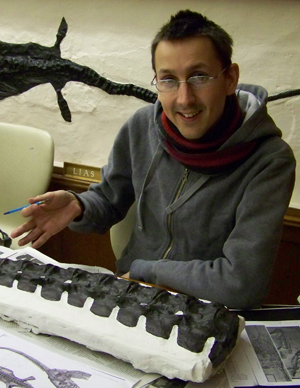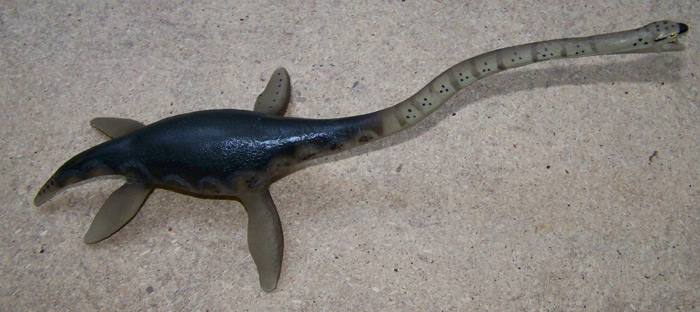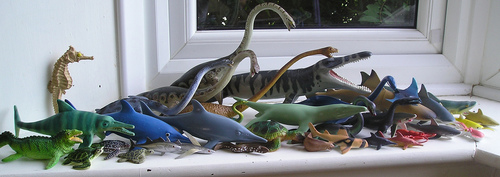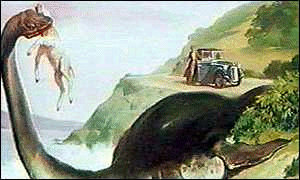
September 2, 2009
This week, I listened to a podcast on plesiosaurs with Dr. Adam Stuart Smith (above) of Dublin’s National Museum of Ireland, Natural History Division.
(Be forewarned, it isn’t Smith’s fault that his hosts use a complete disregard for most of the evidence, including critical dates, found within the Nessies dossier to make their debunking points. MonsterTalk, the cleverly misnamed, new site for this podcast series, is a stalking horse for CSICOP.org, the Skeptical Inquirer, and a variety of other debunking alliances. It is produced, clearly, with a point of view in place, and must be realized for that bias. I counted too many factual errors and spiteful comments to detail or reply to here, within their painfully long intro section. Skip the first 20 minutes and go straight to Smith’s down-to-earth presentation.)
Smith alerted me to several items of interest and discussions that he mentions on his excellent website, which has a variety of links to his papers and talks. The site also demonstrates we share, along with Dr. Darren Naish, a popular culture interest in the use of replicas in our research and educational pursuits.

This plesiosaur shown is a member of Order Plesiosauria as a whole, and belongs to the long-necked Suborder Plesiosauroidea. It is the topic under consideration. Dr. Adam Stuart Smith photo.

This pliosaur, above, is also a member of Plesiosauria, within the Suborder Pliosauroidea, but not the subject of the day. Dr. Adam Stuart Smith photo.

Part of Dr. Darren Naish’s collection.
Nessies Are Not Plesiosaurs

Nessies are not plesiosaurs, despite what sinister artists would have you think.
One point, of course, is that scientists like Dr. Smith and Dr. Naish are still called upon by the debunkers to say all the right things about how the Loch Ness Monster is not a pleisosaur. The Plesiosaur Hypothesis is certainly not an overwhelming concern within cryptozoology, nor is the notion that there’s “one Jurassic Park-type survivor” in that loch. Cryptozoologists have no argument with Smith’s conclusions and Naish’s thoughts on such matters.
Intriguingly, the Plesiosaur Hypothesis is one developed early in the British media promotion of theories to explain reports of unknown animals in Loch Ness in the 1930s.
Most American cryptozoologists, from the beginning, and, indeed, most critical thinking cryptozoologists today reject The Plesiosaur Hypothesis. The mammalian focus and other schools of thought have won out long ago. We realize that these extinct marine reptiles are extinct, and to promote or use them as candidates for Loch Monsters is done mostly by “true believers” (on both sides of the aisle, whether they are pro- or anti-Nessites).
Most cryptozoologists would whole-heartedly agree with Smith’s statements on his website, like this one: “There is no scientific evidence supporting the existence of long-necked plesiosaurs living today and no evidence whatsoever for short-necked plesiosaurs living today.”
As he points out, for example, plesiosaurs did not even have swam-like necks. As Smith observes: “Contrary to early work (Zarnik, 1925, see figure below), the neck did not have the flexibility to coil up and strike prey as do some snakes and pleurodiran turtles (Pough et al. 1996). The neck was actually inflexible (Storrs, 1993), so plesiosaurs could also not adopt the often depicted swan-like pose.”
Various theories by cryptozoologists encompass folkloric traditions, skeptical insights, misidentified pinnipeds and other animals, and the exploration of the survival of varied fossil and extant but undiscovered mammalian forms.
The “Surgeon’s Photo” (two, not one image, btw) has not been held in high regard by mainstream cryptozoologists for decades (as it appeared to be a diving bird or otter). Nevertheless, the legend of the hoax claim is a remarkable story unto itself. The “deadbed confession” did not occur; a tale was told and two years later the man who told it died. The media and the Internet has carried forth the myth of the “deathbed confession.” The materials said to have constructed the alleged but unproven “toy submarine” model were not yet invented and/or in widespread use in 1934.
The alternatives to the The Plesiosaur Hypothesis are just as dynamic and interesting.
Dr. Darren Naish’s paper on crypto-pinnipeds is a landmark contribution in which he has examined the evidence and ventured forth with some challenging insights, for all of us.
Even on a public forum, Dr. Smith noted his open-mindedness and sense of adventure is still alive: “I never mentioned it in the interview, although I wish I had, that despite the lack of convincing scientific evidence for living plesiosaurs, I’d naturally love for a living plesio or two to be discovered. Wouldn’t that be wonderful! There is nothing intrinsically ridiculous about the idea of plesiosaurs surviving to the present day, there just isn’t any scientific evidence for it.”
What Smith does also point out is that there are plenty of unanswered questions about plesiosaurs without dragging poor ole Nessies into the picture.
Why Plesiosaurs Have Long Necks
One ongoing mystery that Smith did allow to surface (pun intended) interested me, and I’d like to propose a solution. For a very successful group of marine reptiles, which lived for 180 million years in various forms, Smith points out that among the plesiosaurs (versus the pliosaurs), their necks increasingly lengthened. But no one knows why.
I notice there is an apparent continued exploration of sexual selection and food adaptations as reasons for the longer and longer necks of plesiosaurs. But I wondered if anyone has thought about or written about another factor of some importance: oxygen? (I’m out of my field of expertise here, so this idea may be already thoroughly explored in the literature, although I couldn’t find anything quickly about it.)
Dr. Smith mentions that the fossils of plesiosaurs are found in areas indicating the animals would have lived in silt-filled water, probably gave birth via living young (not eggs), and were a very successful group of species. He also noted the curious fact of the extreme vulnerability of their long necks.
All this makes me wonder, why evolve a longer and longer neck? There must have been positive reinforcement in terms of survival in having an increasingly longer neck. I pondered, could there be an evolutionary advantage to utilizing shoreline peat-filled and dark-silt waters to hide your long neck, while using and then sticking those long rigid necks just barely up to the surface, only to breathe?
Longer and longer necks could have served the purpose of the heavily weighted down plesiosaurs, with all those stones in their stomachs (gastroliths, above), hanging out at or near the murky, safe shoreline bottoms, in darker, more hidden waters, while, oh, so carefully breaking the surface of the water to breathe.
Growing up in central Illinois, I would often wade deeply into muddy creeks and encounter soft-shelled turtles, by surprise. (Those I could manage; it was the snapping turtles that I had to really avoid.) Despite their relatively large size, these soft-shelled turtles would keep well hidden below the water and merely place the tip of their noses on the surface – after stretching their necks out as long as possible – to breathe. (See image above.)
Also, soft morphology does not show it perhaps, but maybe, like the soft-shelled turtles, the plesiosaurs had nostrils that assisted in this breathing task. Most soft-shell turtles, no matter where they are found in the world, use their long necks in conjunction with their specialized noses. (See above and below.)
After thinking about Dr. Smith’s interview, I wondered, could this be exactly what is occurring with the plesiosaurs? They needed to breathe but they also had to keep their necks protected/hidden from harm.
As opposed to the Nessie-like necks that we both agree the earlier theorists mistakenly proposed for the plesiosaurs, maybe the opposite was occurring. Around the world, no “long necks” were projecting from the marine environment, but lots of little noses were popping up, to breathe safely.
About Loren Coleman
Loren Coleman is one of the world’s leading cryptozoologists, some say “the” leading living cryptozoologist. Certainly, he is acknowledged as the current living American researcher and writer who has most popularized cryptozoology in the late 20th and early 21st centuries.
Starting his fieldwork and investigations in 1960, after traveling and trekking extensively in pursuit of cryptozoological mysteries, Coleman began writing to share his experiences in 1969. An honorary member of Ivan T. Sanderson’s Society for the Investigation of the Unexplained in the 1970s, Coleman has been bestowed with similar honorary memberships of the North Idaho College Cryptozoology Club in 1983, and in subsequent years, that of the British Columbia Scientific Cryptozoology Club, CryptoSafari International, and other international organizations. He was also a Life Member and Benefactor of the International Society of Cryptozoology (now-defunct).
Loren Coleman’s daily blog, as a member of the Cryptomundo Team, served as an ongoing avenue of communication for the ever-growing body of cryptozoo news from 2005 through 2013. He returned as an infrequent contributor beginning Halloween week of 2015.
Coleman is the founder in 2003, and current director of the International Cryptozoology Museum in Portland, Maine.
Filed under Cryptomundo Exclusive, Cryptotourism, CryptoZoo News, Cryptozoologists, Extinct, Forensic Science, Fossil Finds, Giant Cryptid Reptiles, Lake Monsters, Living Dinosaurs, Living Fossils, Loch Ness Monster, Men in Cryptozoology, Museums, Replica Cryptia, Sea Serpents